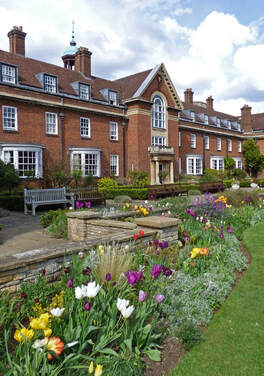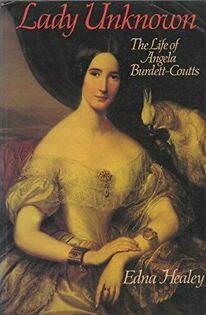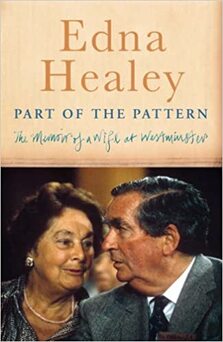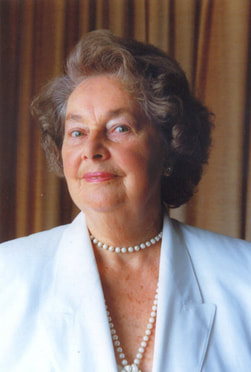EARLY LIFE
Edna Edmunds was born in Newland Street, Coleford on June 14th 1918, daughter of Edward Edmunds and his wife Rosa (nee Crook). Edward worked as a crane driver, employed for over 20 years by United Stone Firms, whilst in later years was in charge of the local water pumping station. Edna's father was also a keen musician, a member of several local choirs, and a founding member of one of the brass bands in the district (Gloucester Citizen, p7 9th January 1933). She was the fourth child born to the marriage, having three older siblings (two brothers and one sister) and one younger sister. The young Edna was brought up in Coleford, the family moving whilst she was still very young to an address on Bank Street (the family home and two neighbouring properties having since been demolished). Edna later remembered (interview with Katie Jarvis, Cotswold Life, September 2007) life in Coleford as growing up: that no drinking water was then laid on to the houses; all lavatories were outside; and bath night involved bathing in front of the fire in the kitchen. More positive childhood memories include the annual Coleford Fair, and attendance at events at the local Baptist Church. Her family were closely involved with the Coleford Baptist Church with Edna, her sisters and mother being members of the choir. Edna later recalled that, ‘The choir was the heart of the chapel. My mother sang in it since she was a little girl [...] she and her friend Nora sang duets like little angels [...] I never hear the Messiah without [...] hearing the familiar voices around me’.
In 1937 the young Edna, aged 18 years, was bridesmaid at her older sister Ivy’s marriage to Gilbert Baldwin, of Walsall. Their father having passed away some years earlier, Ivy was given away by her brother Bert.
A newspaper report comments that ‘the bridesmaid was in almond green, with cape and hat of brown velvet, and she also wore a spray of white carnations’. (Gloucester Journal, p7, 2nd January 1937)
Edna was educated at St Johns school in Coleford, then Bell’s Grammar School. From many accounts, including her own autobiography, Edna did extremely well at school, leading to the recommendation from a teacher (Joan Davis) that she sit an entrance exam for Oxford University. An entry in the local newspaper shows ‘E.M. Edmunds’ being a recipient of a school prize whilst in Form 3 – her older sister Ivy gaining an ‘Election Prize’ in the same year (Gloucester Journal, 5thApril 1930 p7). It was a mistress at the school, Joan Davis, who first suggested the young Edna apply for a place at Oxford University – a suggestion which met with some early opposition from the Baptist minister, who felt Edna would be out of place alongside young women from more privileged backgrounds. Edna writes that, whilst another girl had gained access to a university place a year earlier than herself, she was understood to be the first girl from Bell’s to attain entry to Oxford. Though some of the wider local circle felt it was too big a step her family were very supportive of her going off to University . Edna would later write that, ‘My mother was adamant. “If they say at school she should go to Oxford, then she must try for Oxford”’.
In 1937 the young Edna, aged 18 years, was bridesmaid at her older sister Ivy’s marriage to Gilbert Baldwin, of Walsall. Their father having passed away some years earlier, Ivy was given away by her brother Bert.
A newspaper report comments that ‘the bridesmaid was in almond green, with cape and hat of brown velvet, and she also wore a spray of white carnations’. (Gloucester Journal, p7, 2nd January 1937)
Edna was educated at St Johns school in Coleford, then Bell’s Grammar School. From many accounts, including her own autobiography, Edna did extremely well at school, leading to the recommendation from a teacher (Joan Davis) that she sit an entrance exam for Oxford University. An entry in the local newspaper shows ‘E.M. Edmunds’ being a recipient of a school prize whilst in Form 3 – her older sister Ivy gaining an ‘Election Prize’ in the same year (Gloucester Journal, 5thApril 1930 p7). It was a mistress at the school, Joan Davis, who first suggested the young Edna apply for a place at Oxford University – a suggestion which met with some early opposition from the Baptist minister, who felt Edna would be out of place alongside young women from more privileged backgrounds. Edna writes that, whilst another girl had gained access to a university place a year earlier than herself, she was understood to be the first girl from Bell’s to attain entry to Oxford. Though some of the wider local circle felt it was too big a step her family were very supportive of her going off to University . Edna would later write that, ‘My mother was adamant. “If they say at school she should go to Oxford, then she must try for Oxford”’.
uNIVERSITY EDUCATION

Edna attended St Hugh’s College, Oxford between 1936 and 1939. The change of lifestyle for a young girl born and raised in the Forest was massive, but Edna writes that she soon formed friendships, and became involved in the life of the University. Edna continued to enjoy activities that had been part of her life in the Forest – playing hockey for her college and joining the Bach Choir (where one of her fellow choristers was the future Conservative Prime Minister, Ted Heath). St Hugh’s College website notes that a tutor wrote of Edna that ‘she reads and writes with an infectious enthusiasm’. She graduated in 1939 with a BA (Class II). She remained in Oxford to gain her teaching certificate the following year.
It was whilst attending university that Edna first developed an interest in politics - something which she notes had played little part in her Coleford days. In an interview with Joan Bakewell (Illustrated London News, 1st June 1979) Edna remarks that in Oxford ‘in 1936 undergraduates (were) preoccupied with politics’. She describes having joined various societies in her early days at university, before settling on, and remaining with, the Labour Club.
It was at university that Edna first met her future husband, Denis Winston Healey, who was a student at Balliol College. He, for part of his time at university, was President of the University Labour Club. Denis is on record as having called Edna by the nickname of Tomato Face at Oxford – due to her rosy cheeks! Although the couple met before the war it was only at the war’s end that they married. During the interim, whilst Denis served in the military, Edna trained as a teacher. One of her first posts was in Keighley, coincidentally Denis Healey’s home town. The couple got to know each other more at this time, before Denis was drafted into the army. Thereafter, for much of the war Edna lived and taught in Bromley.
It was whilst attending university that Edna first developed an interest in politics - something which she notes had played little part in her Coleford days. In an interview with Joan Bakewell (Illustrated London News, 1st June 1979) Edna remarks that in Oxford ‘in 1936 undergraduates (were) preoccupied with politics’. She describes having joined various societies in her early days at university, before settling on, and remaining with, the Labour Club.
It was at university that Edna first met her future husband, Denis Winston Healey, who was a student at Balliol College. He, for part of his time at university, was President of the University Labour Club. Denis is on record as having called Edna by the nickname of Tomato Face at Oxford – due to her rosy cheeks! Although the couple met before the war it was only at the war’s end that they married. During the interim, whilst Denis served in the military, Edna trained as a teacher. One of her first posts was in Keighley, coincidentally Denis Healey’s home town. The couple got to know each other more at this time, before Denis was drafted into the army. Thereafter, for much of the war Edna lived and taught in Bromley.
marriage & family
Edna married Dennis Winston Healey in December 1945. They honeymooned in the Dales. Denis' mother’s family lived in Newnham-on-Severn, a small Forest of Dean town on the banks of the River Severn. His grandfather (Edwin Stephen Powell) was station master there.
Denis entered political life soon after the marriage, the couple living variously in Kentish Town, and Highgate, before entering the first of many official ministerial residencies. Work responsibilities inevitably led to Denis spending periods away from home. By 1952, just 7 years after their marriage, Denis was MP for Leeds South East. He later rose in the party to become firstly Defence Secretary and later Chancellor of the Exchequer. During this time Edna raised the couple’s three children – Timothy, Jennifer and Cressida. Edna is quoted as observing that ‘You’re a one-parent family when you are married to an MP’. As the family got a little older, Edna sometimes accompanied Denis on his trips abroad. An article in The Guardian, which appeared after her death in July 2010, includes a description from one such journey, from Denis’s political colleague, former Labour Party leader Neil Kinnock: ‘We were travelling by train from Moscow to what was then Leningrad...I started to hum Lara’s Theme from Dr Zhivago and before I knew it Denis was waltzing (along the platform) with Glenys (Kinnock) and I was waltzing with Edna’!
In a Cotswold Life interview Edna describes a visit from Forest writer Leonard Clark to the family home in London. She pointed out to him the daffodils, bluebells and violets she had planted in the garden. He asked where she ‘intended to plant the bracken’ – at which point she recognised that she had recreated some little bit of the Forest of Dean in her garden. Once Denis’ active political career came to an end, the couple bought a home in Alfriston, East Sussex.
Denis entered political life soon after the marriage, the couple living variously in Kentish Town, and Highgate, before entering the first of many official ministerial residencies. Work responsibilities inevitably led to Denis spending periods away from home. By 1952, just 7 years after their marriage, Denis was MP for Leeds South East. He later rose in the party to become firstly Defence Secretary and later Chancellor of the Exchequer. During this time Edna raised the couple’s three children – Timothy, Jennifer and Cressida. Edna is quoted as observing that ‘You’re a one-parent family when you are married to an MP’. As the family got a little older, Edna sometimes accompanied Denis on his trips abroad. An article in The Guardian, which appeared after her death in July 2010, includes a description from one such journey, from Denis’s political colleague, former Labour Party leader Neil Kinnock: ‘We were travelling by train from Moscow to what was then Leningrad...I started to hum Lara’s Theme from Dr Zhivago and before I knew it Denis was waltzing (along the platform) with Glenys (Kinnock) and I was waltzing with Edna’!
In a Cotswold Life interview Edna describes a visit from Forest writer Leonard Clark to the family home in London. She pointed out to him the daffodils, bluebells and violets she had planted in the garden. He asked where she ‘intended to plant the bracken’ – at which point she recognised that she had recreated some little bit of the Forest of Dean in her garden. Once Denis’ active political career came to an end, the couple bought a home in Alfriston, East Sussex.
writer & broadcaster

Edna became a successful author in later life, with her success leading on to her making / presenting documentaries, and being a participant in numerous TV and radio broadcasts. Edna’s meticulous research into her subjects, perhaps assisted by connections with people able to aid her access to such resources, led to her completion of a number of extremely well received biographies and other historically focussed works.
The inspiration for Edna’s first biography came from living with Denis and her family in a property in the grounds of the former home of Angela Burdett-Coutts. As her husband had, by the late 1970s, ended his ministerial career, Edna found she had at last the time to tend to her own pursuits as well as be a mother and a support to his political career. She determined to research, then to write, about Angela’s life.
Angela, the philanthropic Lady Unknown, had inherited a vast fortune from her grandfather, the banker Thomas Coutts. As Edna writes: ‘the list of Angela’s charitable works is endless’. Her life was entwined with friendships with key figures of her day, including the Duke of Wellington and Charles Dickens. The book was published in 1978. Due to Angela Burdett-Coutts’ friendship with Charles Dickens, Edna became for several years the President of the Dickens Fellowship (1979 – 1981). Lady Unknown became a best-selling biography, and led on to Edna writing further books, many of which focussed on ‘the women behind the men’. Away from this theme, Edna also wrote a history of Coutts Bank and one about Buckingham Palace. Concurrent with the first book’s publication, Edna was one of a panel of speakers at the Birmingham Post Literary Lunch. The other speakers at the event were Elizabeth Jane Howard (author of an anthology entitled The Lover’s Companion) and Peter Townsend, former Equerry to King George VI (whose book entitled Time and Chance was about to be published) (Birmingham Daily Post, p1 23rdJan 1978). Edna’s final published work was her memoirs, entitled Part of the Pattern (2006).
As a public speaker and educator Edna often lectured about Dickens, including talks to the Workers Educational Association (WEA) and the English-Speaking Union. She continued lecturing and broadcasting into her early 90s.
Writing in the Illustrated London News (1st July 1979) Joan Bakewell describes an interview with Edna Healey. She asks Edna why she feels that people identify with her and her writing. Her reply? ‘I think it is because I look a bit like mum’! By the early 1980s Edna was appearing on TV, in documentaries shot on location, and on radio. Edna made two film documentaries. The first, broadcast in January 1982, told the story of the wife of David Livingstone and was entitled Mrs Livingstone, I Presume. The second, broadcast In December 1984 was a presentation about the life of Mary Slessor, who had gone as a Christian missionary to Africa 100 years previously (Sunday Mirror, 30thDecember 1984). 1984 also saw Edna in conversation on BBC Radio 4 with Forest author Winifred Foley, in a broadcast entitled Two girls in the Forest (Reading Evening Post, 1st November 1984).
Despite living away from the area, Edna returned throughout her lifetime, to visit her family in Coleford, and in connection with various local activities. Other TV appearances included being on the panel of Read All About it in November 1978. Hosted by presenter Ronald Harwood, other panellists included both Winifred Foley and Laurie Lee.
The inspiration for Edna’s first biography came from living with Denis and her family in a property in the grounds of the former home of Angela Burdett-Coutts. As her husband had, by the late 1970s, ended his ministerial career, Edna found she had at last the time to tend to her own pursuits as well as be a mother and a support to his political career. She determined to research, then to write, about Angela’s life.
Angela, the philanthropic Lady Unknown, had inherited a vast fortune from her grandfather, the banker Thomas Coutts. As Edna writes: ‘the list of Angela’s charitable works is endless’. Her life was entwined with friendships with key figures of her day, including the Duke of Wellington and Charles Dickens. The book was published in 1978. Due to Angela Burdett-Coutts’ friendship with Charles Dickens, Edna became for several years the President of the Dickens Fellowship (1979 – 1981). Lady Unknown became a best-selling biography, and led on to Edna writing further books, many of which focussed on ‘the women behind the men’. Away from this theme, Edna also wrote a history of Coutts Bank and one about Buckingham Palace. Concurrent with the first book’s publication, Edna was one of a panel of speakers at the Birmingham Post Literary Lunch. The other speakers at the event were Elizabeth Jane Howard (author of an anthology entitled The Lover’s Companion) and Peter Townsend, former Equerry to King George VI (whose book entitled Time and Chance was about to be published) (Birmingham Daily Post, p1 23rdJan 1978). Edna’s final published work was her memoirs, entitled Part of the Pattern (2006).
As a public speaker and educator Edna often lectured about Dickens, including talks to the Workers Educational Association (WEA) and the English-Speaking Union. She continued lecturing and broadcasting into her early 90s.
Writing in the Illustrated London News (1st July 1979) Joan Bakewell describes an interview with Edna Healey. She asks Edna why she feels that people identify with her and her writing. Her reply? ‘I think it is because I look a bit like mum’! By the early 1980s Edna was appearing on TV, in documentaries shot on location, and on radio. Edna made two film documentaries. The first, broadcast in January 1982, told the story of the wife of David Livingstone and was entitled Mrs Livingstone, I Presume. The second, broadcast In December 1984 was a presentation about the life of Mary Slessor, who had gone as a Christian missionary to Africa 100 years previously (Sunday Mirror, 30thDecember 1984). 1984 also saw Edna in conversation on BBC Radio 4 with Forest author Winifred Foley, in a broadcast entitled Two girls in the Forest (Reading Evening Post, 1st November 1984).
Despite living away from the area, Edna returned throughout her lifetime, to visit her family in Coleford, and in connection with various local activities. Other TV appearances included being on the panel of Read All About it in November 1978. Hosted by presenter Ronald Harwood, other panellists included both Winifred Foley and Laurie Lee.
BOOKS
- Lady Unknown, the life of Angela Burdett-Coutts (1978)
- Wives of Fame (1986)
- Coutts and Co (1992)
- The Queen’s House: A History of Buckingham Palace (1997)
- Emma Darwin (2001)
- Part of the Pattern (2006)
broadcasts
- Mrs Livingstone I Presume (1982) [presenter]
- One More River, the life of Mary Slessor in Nigeria (1984) [presenter, scriptwriter]
HER WRITING ON THE FOREST OF DEAN
Much about how the Forest and her upbringing may have influenced her later life can be gleaned by reference to Edna’s memoirs, Part of the Pattern, the first chapter of which focuses on her childhood in Coleford. This is augmented by comments about the Forest which she made in the numerous interviews in which she took part in later life. Speaking of the Forest and early family trips to localities such as Symonds Yat, Edna writes:
From earliest childhood I absorbed its ancient history almost without knowing. ...our playgrounds were reminders of past ages...in our games we followed the invaders, Roman, Saxon, Viking and Normans, through a network of hollow-ways and old tracks among the woods.

Edna mentions her husband Denis’s family ties with riverside Newnham, and tellingly when considering her views of the boundaries of the Forest comments that, ‘Newnham was a holiday for him...Indeed; I never felt the Severn-side boundary of my world was truly part of the Forest of Dean: it was too pastoral’. Edna displays a sense of pride in her family’s strong links with the Forest of Dean. Although her father’s family came into the area from Wales, her father Edward was born in the Forest and her mother came from a family, ‘whose roots were deep in the Forest’. She also notes that her father had fulfilled all the requirements that would have permitted him, had he wished, to become a Freeminer. Edna describes the Coleford of her childhood in realistic yet affectionate terms: ‘In my day (the clock tower) stood beside the Town Hall, where concerts and dances were held, and a market hall, where a penny would buy liquorice or a slab of nutty chocolate, or coconut ice, or gobstoppers that rainbowed to an aniseed pip in the centre [...]I do not remember being bored. There was always the ‘Rec’.....my brothers played golf and my sisters and I belonged to a tennis club’. Edna describes ‘people-watching’ from the windows of their house – a home which lacked so many of the amenities taken for granted in the modern world: ‘We had no radio until I was sixteen....The house was cold, in winter the water in the bedroom jugs froze [...] The kitchen and sitting-room were gas lit, otherwise we carried candles. I did my homework by the light of an oil-lamp in the front room, wearing my coat’. The young Edna was very aware of the passing of the seasons across the Forest year:
There were primroses and daffodils to be picked in the spring, wild strawberries in summer, and in the autumn apples and plums in the allotment, blackberries in the hedgerows, and hazelnuts to be pulled down from pliant branches.
later life & death
Maintaining her strong links with the Forest, Edna became a member of the Forest of Dean Local History Society. Her obituary in the Society newsletter (Oct 2010) reflected on a talk she gave to the Society in Coleford Baptist Chapel, so familiar to her from her childhood, on the occasion of the Society’s 50th anniversary. She also opened a History Fair in Lydney, run by the Society. Edna also served as Patron of the Friends of the Cathedral of the Forest, Newland. She was patron to Voices in the Forest and appeared at the first Voices in the Forest Festival in 2004.
Edna passed away in hospital in Eastbourne on 21stJuly 2010. She died of heart failure, aged 92 years. Her husband Denis died five years later.
Edna passed away in hospital in Eastbourne on 21stJuly 2010. She died of heart failure, aged 92 years. Her husband Denis died five years later.
Many thanks to Caroline Prosser-Lodge for her research and writing for this page.



